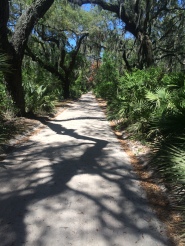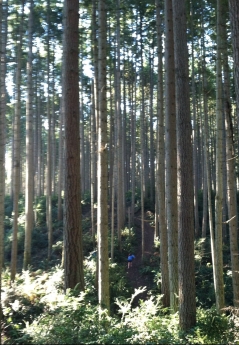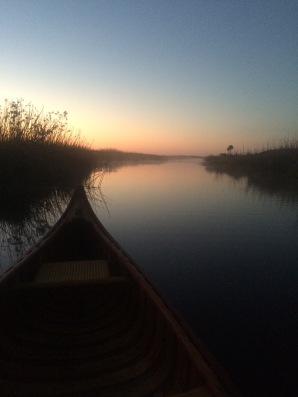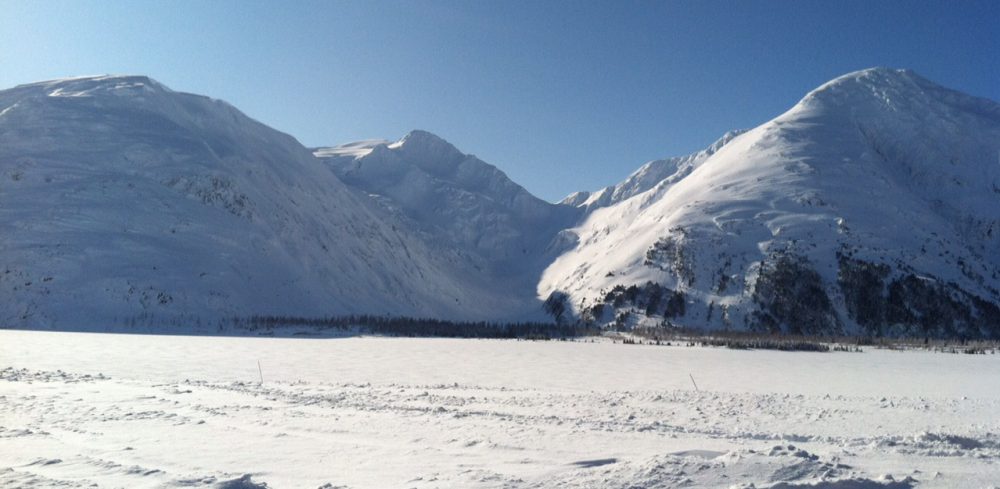Source: Transitions…and Sled Dog Crazy
Transitions…and Sled Dog Crazy
When the weather cooperates the thousand-mile Iditarod sled dog race starts near Willow Alaska – eighty miles north of Anchorage. Imagine a frozen lake, a mile or so across under a pink predawn sky.  It’s minus fifteen on the first Sunday in March. A single Husky-Malamute mixed breed starts her day with a long, lonely howl…
It’s minus fifteen on the first Sunday in March. A single Husky-Malamute mixed breed starts her day with a long, lonely howl…
“Helloooo!” She waits, staring across the ice through crystal blue eyes. From some distant camp another mixed breed replies, “Helloooo!”
From some distant camp another mixed breed replies, “Helloooo!”
It’s haunting. It’s beautiful. It’s Amazing.
It’s not like that at all. It’s frozen-lake, sled dog crazy.
More than sixty mushers start the Iditarod with sixteen dogs per sled. The big money teams bring extra dogs in case somebody’s out of sorts. ‘Nearly a thousand dogs on the ice, all of ‘em bred to run. All of ‘em have their own personality – good, bad, passive, aggressive. And all of ‘em have something to say about race day. You have to shout to the person standing at your side to be heard. That’s frozen-lake, sled dog crazy.
Our Life-Transitions can feel kind’a crazy. Not just because there’s a lot of uncertainty and multiple uncharted paths ahead. Transitions feel crazy because we’re in relationship with others who are dealing with their perspectives on their own transitions, and yours. Maybe yours is a job change and theirs is the way you’re transition changes their world. Add kids, a parent or two, three close friends, a realtor, mortgage lender, a new boss (all in some transition of their own), an agreement or two from childhood that bark FEAR!, PERFORM!, SUCCEEEEEED! …yep, it’s sled dog crazy time. ‘Gets ruff.
Is there a way to avoid a fight between two well-bred creatures at the starting line of another transition?
‘Short answer’s yes. I SAID; THE SHORT ANSWER IS YES!
William Bridges’ book Transitions – Making Sense of Life’s Changes is a great resource.  The book of Proverbs is too. “Even a fool, when he is silent, is considered wise” (17:28) is good advice when the pressures of transition tempt you to bark… Be smart. Don’t bark.
The book of Proverbs is too. “Even a fool, when he is silent, is considered wise” (17:28) is good advice when the pressures of transition tempt you to bark… Be smart. Don’t bark.
‘Three suggestions for the start of a healthy transition:
1. Bark less…wag more
2. Remember, you’re not the only dog on the ice. Everybody’s in some kind of transition.
3. Focus on the race. We’re here for the race and the reward…not the sled dog crazies.
Transitions…
“So, what’s next?”
It’s a question we ask ourselves and hear from others in times of transition. It always reminds me of that question at Thanksgiving and family gatherings long ago, “What do you want to be when you grow up?”
At some point…maybe graduation weekend…we’re supposed to know. Our Facebook profile demands it. A few are blessed to have it all figured out. For better or worse, some have it handed to them on the proverbial platter.
Most of us are blessed with multiple seasons of uncharted transitions throughout our grown up years. ‘Some by choice. Others by tragedy. The majority are simply a function of living.
So…What’s next?
‘Don’t know…but I do know transitions are perfect times for multi-day hikes, paddles or two-wheel adventures. For your sake and for the new community in your life, carve out a Transition Trip in preparation for, or recovery from the next transition. Don’t miss the opportunity to breathe deeply in big spaces, spaces infinitely bigger than your transition.
Don’t miss the opportunity to breathe deeply in big spaces, spaces infinitely bigger than your transition.
Transitions, by choice, tragedy or just because, can be sacred seasons. You can be different. You probably need to be different for what’s next. And out there, outside, there’s space and time to create clarity, to find and define Different, to remember the most important Whys in your life, to rediscover your True North.
Who knows this side of heaven what the next transition holds for you. But the last thing you want to do, the worst thing you can do, is miss the opportunity to grow and stretch and find your better self, better suited for this next season.  Don’t step out of one square office and plop down in another square office without taking even three days to ask, “What needs to change?” “What should stay the same?” “What’s best in me for this next season?” “What doesn’t work anymore?” “Who can help me see?”
Don’t step out of one square office and plop down in another square office without taking even three days to ask, “What needs to change?” “What should stay the same?” “What’s best in me for this next season?” “What doesn’t work anymore?” “Who can help me see?”
For most of us, transition’s coming. Decide, now, to take that Transition Trip. People you haven’t met yet will be grateful – even if they don’t know why.
So, what’s next?
Better, friend. Much better.
Journey Follows
It happened again this week…I was talking to a friend about a recent overnighter on the Suwannee River. As I shared our trip Greg’s eyes lit up and he jumped into his own story of adventure on the Suwannee. It included a cold night in February, a friend falling out of the canoe, food and gear floating away, not enough dry clothes, building a fire…every detail was top of mind. It was right there for Greg, and he took me there too. I could see it. I could feel that ice cold water.
It happened over ten years ago.
How many class room experiences do you remember from ten years ago? How many sermons, instructional videos, podcasts, staff training events can you describe in detail, with enthusiasm, from February, 2007? I’m guessing not too many.
 I’m fascinated with the place of Journey. I’m convinced Journey is at the heart of our becoming fully human. I believe Journey reveals those parts of ourselves that are closed and dying and helps us discover how to grow more open and alive. I believe Journey teaches us in ways no lesson outline, no educational outcome, no pedagogical process could every predict.
I’m fascinated with the place of Journey. I’m convinced Journey is at the heart of our becoming fully human. I believe Journey reveals those parts of ourselves that are closed and dying and helps us discover how to grow more open and alive. I believe Journey teaches us in ways no lesson outline, no educational outcome, no pedagogical process could every predict.
And I believe Journey Follows. It follows us back home to the familiar and into the new. Journey imprints every sense in high def: touch, taste, smell, sight, sound. And once it does that, as only Journey can – ten years, fifteen, forty, sixty…it doesn’t matter. It’s still in there.
 I think – I know – if you need to discover something about yourself, if there’s a season of “new” coming or hoped for, if you need to be different for all that will be different very soon, Journey is the place to prepare. That’s ancient truth. Journey.
I think – I know – if you need to discover something about yourself, if there’s a season of “new” coming or hoped for, if you need to be different for all that will be different very soon, Journey is the place to prepare. That’s ancient truth. Journey.
And don’t worry about missing it when it’s done… Journey Follows.
Journey Teaches
For the past several months I’ve been considering the place of Journey in a life well lived. Specifically, what difference does Journey make? Am I just an adrenalin junkie trapped in an aging Boomer’s body? Is Journey my drug of choice? Probably so. But I also believe Journey Teaches. A couple months ago I suggested, “Journey teaches us dependence and interdependence and independence…all at the same time.”
Long ago and far away one of my graduate courses in education introduced me to the concept that “Learning is change.” If there’s no change, learning hasn’t occurred. Basically, you’re the same dumb schmuck you were before class.
Before the Journey, you have a sense of control, of authority, or at least familiarity. You know the language, the pecking order, the norms, what’s cool, what’s way uncool. You pretty much know what comes next. Journey teaches us to use the phrase, “Can you help me, please?” We discover we are in fact dependent on others for basic necessities.
Before the Journey, you may think interdependence is for the weaker ones, the ones who can’t make it on their own. They need others…not me. Journey teaches, Journey celebrates, interdependence. The hostel, the shelter, the bus ride with a goat, four roosters and a drunk are memories too rich to hoard and impossible to explain. And it’s more than merely shared memories…we were created for community. That’s part of the lesson.
Before the Journey, you may have lived in fear, intimidated by the Accepted Ones, by th ose who know how the system works, the ones who always win. Journey teaches independence. As you go, when you return, you can know without saying a word, “I did, I can, I will.” Repeat. “I did, I can, I will.” Repeat.
ose who know how the system works, the ones who always win. Journey teaches independence. As you go, when you return, you can know without saying a word, “I did, I can, I will.” Repeat. “I did, I can, I will.” Repeat.
It’s not about being better than ‘them’. It’s about being you. It’s about learning the You who figured it out, who made the climb, who dried out and kept going.
Journey teaches…dependence. Journey teaches…interdependence. Journey teaches…independence. Class is in session.
Let’s go.
Journey Reveals
I can’t prove it without a lot more study, but I think every time God invited some Patriarch or Champion to make a big difference with their one short life, He invited them, or forced them, to Journey. Last month I suggested, “…journey reveals our pinched perspective. It forces us to stretch – or break. Before the journey we see life as it exists from a limited field of view…through slats in the fence, wearing scratched, clouded, hand-me-down glasses.”
A dozen years ago Alan Deutschman wrote Change or Die. His research says, people will literally choose death over change. You’ve seen it. Smart, sincere people will allow a marriage, a family, a church, a career, to die rather than change their actions, attitude or perspective.
It’s hard to stand in front of the same mirror everyday, day after day, committed to being a responsible adult…and then one day say to the face in that mirror, “You’re wrong.” And it’s harder still to follow that admission with real change. We’d rather die.
That’s the place of journey. The mystics called it a “pilgrimage.” Academicians call it a “sabbatical.” High schoolers with insight call it a “gap year.” The d ead people in Deutschman’s book called it “irresponsible.”
ead people in Deutschman’s book called it “irresponsible.”
Journey reveals the truer perspective. Have you ever said, “You can see it better from here”? Journey reveals the larger Truth, the bigger ‘Yes’. The bigger ‘Yes’ gained by going beats a thousand little ‘no’s’ stuck in the staying. Journey reveals the power of grace and forgiveness. What if you physically opened you hand wide, and turned it upside down, and wiped it off with your other hand and let go of that grudge, that unforgiving burden you carry against that person you nearly hate…and what if you did that a thousand or two thousand miles from home…and what if you left it there, permanently?
Deutschman’s warning is Change or Die. Journey’s invitation is Come and See.
The Place of Journey
I’ve been thinking a lot lately about the place of journey in our life story.
Here’s what I think: You need it. Everyone needs it. We were created for it. Big stuff happens on, because of and after Journey.
You need to go on a physical, point A to B to C to Z, over the road, land, air and water Journey. I’m not sure it matters where. Preferably someplace relatively safe (no IED’s, drug cartels, or Ebola outbreaks). It’d b e nice if it’s pretty, but that’s not required. What is required is that you GO, that you MOVE. And the further, the more outside that proverbial, life sucking box, the better.
e nice if it’s pretty, but that’s not required. What is required is that you GO, that you MOVE. And the further, the more outside that proverbial, life sucking box, the better.
A metaphorical “journey of the inner man” is fine, as far as it goes. The problem is, it doesn’t go very far at all.
I can think of at least three life-giving ways God uses Journey to restore us to His order. I think I’ll unpack each in subsequent posts…
First, Journey reveals our pinched perspective. It forces us to stretch – or break. Before the Journey we see life as it exists from a limited field of view; we see it through slats in the fence, wearing scratched, clouded, hand-me-down glasses. It’s easy to be certain of the way a tiny world works. But Creation isn’t tiny. It’s really, really big.
Second, Journey teaches us dependence and interdependence and independence…all at the same time. It’s magic. We’re not nearly as strong as we think, they aren’t nearly as different as we thought, and we really are far more capable of so much more than we ever imagined.
Third, Journey goes with you. It follows you home. Informing. Shaping. Filtering. Judging. That distant dark sky, rain on the tin roof of an open shelter, that manatee rolling over for a belly scratch, the call to prayer from the minaret, roosters up before dawn right outside your window and thin air above 14,000 feet…it’s all still there. Nothing you see after the Journey looks like it would have had you never gone. And that’s a good thing.
Hope and the J-stroke
It’s been cool to be cynical for so long now we’ve forgotten the meaning of Hope. For most of us Hope means, “Fat chance.” Powerful people sound so smart snarling, “Hope is not a strategy.” And the hopeful look so foolish with their eyes on the skyline.
Biblical Hope isn’t fat chance wishing. Biblical Hope is confident assurance. Biblical Hope is trusting it will work out because of the One in whom we trust. Every time. Trusting before it happens.
When I’m sitting in the stern of Restoration, or Tammy, or Big Boat and pull my paddle just past my right hipbone, then roll the grip over till my left thumb points to the water and finish the stroke with a slight push out with my right hand, the boat tracks straight. Every time…every time…every time…every…time.
It’s not magic. I’m not luckier than the guy in the canoe that just won’t go straight.
Confident assurance. It creates forward momentum in a preferred direction.
If it’s been a while, revisit your view of Hope. Fat chance, or confident assurance? Biblical Hope is a solid strategy for a life of forward momentum in a preferred direction.
Biblical Hope is a solid strategy for a life of forward momentum in a preferred direction.
Is That a Monkey or an Owl?
 We’d been looking for them all morning. Seeing a Rhesus monkey from one of the colonies on the Silver River in the Ocala National Forest would make the trip for Cindy and our friend Terri. We were straining to catch a glimpse of just one little monkey out in the forest as we paddled upriver toward the springhead.
We’d been looking for them all morning. Seeing a Rhesus monkey from one of the colonies on the Silver River in the Ocala National Forest would make the trip for Cindy and our friend Terri. We were straining to catch a glimpse of just one little monkey out in the forest as we paddled upriver toward the springhead.
I think it was Terri who saw it first…”There’s a monkey!”
“Where!?”
“Right in front of your boat…on that limb…back in the woods… Can’t your see it??… Right in front of you!…”
Cindy was staring straight at it with an unobstructed view when it moved…”That’s an owl! It’s a young owl!”
I chimed in from further up stream, “I see it!…It’s a monkey…he’s dark and his head is kind’a tucked in between his shoulders…”
The conversation went on for maybe three minutes. “It’s an owl…It’s a monkey…It’s an owl…What are you looking at?…Right there, about fifty feet back in the woods…That.is.an.owl!…It’s too late in the day for an owl…No, wait…he just looked straight at me; that’s an owl…Are you sure??”
Eventually we all saw the owl.
And later in the day we all saw more than a few monkeys. Unmistakably Rhesus monkeys, looking for food, protecting their turf, loving their young, swinging from branches, feasting on berries and insects near the water. Not one of ’em even remotely resembled the owl we had seen just a few hours earlier. But just a few hours earlier, two out of three people were convinced that adolescent owl was a monkey.
It reminded me how easily we can see what we want to see regardless of what’s really there. How often do I decide what something is, who someone is, how to interpret the circumstances, what the Truth is, what this passage really means…long before I’ve actually seen it, seen them, seen the Truth, for what it is, really. Majority rules: That’s a monkey. I’m not deconstructing Truth. I just want to see Truth unclouded by traditions or expectations or prejudices.
It’s harder than it sounds. Good hearted people will swear that an owl is a monkey. If you want to see something a certain way, if it’s what you came out to see, seeing something different, even a better thing that’s different, is really hard.
So…is that a monkey…or an owl?
Old School Navigation and Leadership Back in the World
I go into fight-or-flight mode when the instruction manual for something with an “On/Off” button is thicker than the thing being turned on or off. I don’t think I’m a Luddite, but when a three ounce gadget comes with eight ounces of instructions I get a little nauseous. Ditto for anything that requires six giga-bites of available memory to download the instructions.
Maybe that’s why I’ve felt a little smug reading the recent spate of articles in the outdoor/adventure rec magazines “introducing” old school map and compass navigation.
Our last trip was off the cell service grid and I don’t own a GPS. I called the USGS office in DC. A real live friendly person answered the phone and I had my topo for the North Prong of the St. Mary’s in hand in three days. I used it to track our progress and find our campsite – off the grid, batteries not included and definitely not required.
If you don’t have a clue where to start with map and compass, check out the Silva tutorials on YouTube. You’ll be ready for a hands-on practice session in thirty minutes.
What does old school map and compass have to do with life back in the world?
I’m still talking to next-gen leaders whose supervisors have apparently forgotten some very basic leadership skills when it comes to the staff they serve. Like the guy who’s spending most of his time in important meetings on personal calls, or the senior leader who can’t keep a confidence, or a supervisor playing games with a guaranteed moral failure, or the guy with an ego so huge he can’t even hear how ridiculous he sounds in his own meetings. This stuff is so basic. This is ‘red tip points north’; ‘bottom of the map is south’, ‘contour lines show elevation change’ stuff.
It doesn’t take long for basics to be lost or never acquired when “new and improved” comes along, particularly when “new and improved” is pretty cool and works pretty well. But some skills, some common decencies, can’t be replaced. And if the departing generation has forgotten that in the rush toward Wow, at least the generation coming up can decide right now, that will not happen on our watch. It doesn’t have to, and you get to choose. It’s simple old school navigation with a well-informed moral compass that’ll keep you on course and get you home safe and sound.
